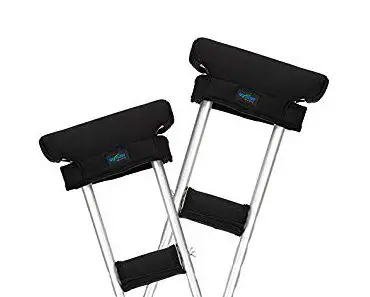Whether you have recently experienced intervention of your leg, or you have a broken ankle, using crutches must be the first step of your overall plan for rehabilitation. Traditionally and in case it’s your first time being your crutches (or if you feel quite difficulties in getting used to them) crutches come in a pair. Or in short, you should wear two crutches.
Though, there’s always one BUT! In this material, we are going to discuss one of these BUTs or to be more concrete, we are going to check out if there is a reason, away, as well as a point of wearing one crutch. Here is our guide as to how to use one crutch…

Is there any specific reason to use only one crutch?
Yes, there is. But before telling you why, here’s one mark to make – it’s all about switching to use only one crutch, but not constantly moving along with a single crutch. It’s important for you to continue wearing both of the crutches.
However, it’s also very convenient once in a while and in specific cases to switch to one crutch only. It’s for the sake of your better comfort, as well as to eliminate a certain discomfort.
Meanwhile, there are occasions when it might be more difficult for you to make a certain movement with two instead of one crutch only.
Top cases when it’s better to use one crutch

Below, we would like to give you a couple of examples for cases when it’s better to use one crutch. Hence, don’t leave the other second crutch too far away from you as once the certain movement or necessity to use one crutch passes, you will have to proceed to wear the standard pair of two crutches:
1. Carry groceries
2. Moving with big luggage
3. Feeling one of your arms in severe pain while moving for a long distance or a long time with both of the crutches
4. Desire to have one of your hands-frees to serve your kid or help someone else
5. Negotiate the stairs in case you can find additional support in a railing form
What should I be very attentive about when using one crutch?

It’s not constant using one crutch. It’s just switching to one except for wearing them both. In other words, what we mean is that there’s a certain pack of risks you can face when performing this switching. Here are the things you should be sincerely attentive and careful about when using only one crutch:
1. When using one crutch you will have to add additional pressure and even a certain dose of discomfort to the leg that’s actually injured
2. There’s a risk of falling
3. There might be some additional (in most cases temporary) pain in the hand/arm that’s linked to the side of the single crutch you use
4. You might lose a certain level of balance in comparison to your normal walking with two crutches
5. Never push yourself too hard and always slow down the speed when switching to one crutch
6. Attention: not all first attempts to use one crutch are successful, so if you feel any difficulties in this movement, skip it and try the next time.
How to use one crutch when walking on a standard flat surface?
The most important thing is putting the crutch under the arm that’s opposite of your injured leg. It’s normal to think off that in this way you are going to minimize the risk of point 3 from the previous paragraph. The next thing to consider is the specific side to use the crutch on.

If asking any medical expert, he or she will tell you to put the crutch right above the arm on the side of your stable leg. Meanwhile, the type of injury and the stage of your rehabilitation also matter for choosing the way you will wear one crutch. You might need to transfer the weight to your healthy leg.
The top tip we can give you, on the other side, is to keep yourself stick to one rule: positioning and balance are the main factors of proper use of one single crutch only. What we mean is that you should adjust your crutch attentively and make sure you feel balanced enough before making the first step.
There should be padding on both the handgrip and armpit support of your crutch. Padding provides better grip and shock absorption. Avoid wearing bulky shirts or jackets while walking with a single crutch as it can lead to reduced movement and stability.
And when the first step to making with one crutch comes…
Yes, that might be a bit frustrating and most of you might be scared to perform this task. Though, don’t worry, if you follow our recommendations you are going to be just fine. Of course, if you feel too scary, better have someone nearby for support.
1. Transfer the crutch about 10 inches ahead of you. Now, make the first step with your injured leg.
2. Now, it’s time to step past the crutch by using the support of your healthy leg and during this movement, you should grab the handgrip with a finely stretched hand.
3. Avoid keeping your weight with your armpit. This is how you will eliminate the risk of side effects of your one-crutch challenge like soreness, nerve damage or any other serious injury.
How to use one crutch on the stairs?
Let’s start with good news – it’s much easier to walking down and up the stairs with one crutch instead of doing it with the complete pair of two crutches. Below, you can read our tips regarding how to use one crutch when stairs are ahead of you:
1. If there are no stair rails, you should try to use one crutch. In this case, it’s actually better to ask for help or get the elevator as it’s going to be hard for you to walk up or down the stairs with two crutches, as well.
2. On the other side, once you feel the release of having a railing in front of you start with taking it with one hand and carry one the crutch in the other as you climb up the stairs.
3. Once you begin climbing the stairs, take the crutch underneath the arm of your healthy leg side and then, take the railing with the hand from your traumatic side. Make sure to transfer the pressure on the railing and the crutch on the opposite side at the same time. Now, it’s time to step up with your uninjured leg first.

4. Repeat the procedure with the rest of the stairs and remember – balance is the key. If you feel tired, unbalanced or in any discomfort, take a deep breath and step aside for a while to relax. There’s no need to rush.

5. Last, but not least, if you now have to take down the stairs, don’t forget that it’s hard to perform this activity both: with one and with two crutches. If you use only one crutch, grip the railing nicely and put your unhealthy leg on the lower step first.

6. Now, follow by the crutch on the opposite side and your healthy leg. Don’t put too much pressure on your injured leg, though, because a sharp jolt of pain may make you nauseated or dizzy.
Conclusion
Now, when you know how important it is to be careful when using one crutch, as well as what the most appropriate occasions for performing such a movement are, you can make some tests on a flat surface at first and then, try the procedure on the stairs.
Please, let us remind you that these are not recommendations from a real doctor and the material has only informative character. Always ask your therapist if a certain use of crutches or one crutch only is appropriate for your individual medical case.






